

Collaborative Learning. 6-12 Collaboration Rubric (CCSS Aligned) Top 5 Ways to Teach Collaboration. Deeper Learning: A Collaborative Classroom Is Key. What's ideal when it comes to collaboration in our classrooms?
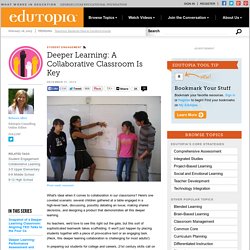
Here's one coveted scenario: several children gathered at a table engaged in a high-level task, discussing, possibly debating an issue, making shared decisions, and designing a product that demonstrates all this deeper learning. As teachers, we'd love to see this right out the gate, but this sort of sophisticated teamwork takes scaffolding. It won't just happen by placing students together with a piece of provocative text or an engaging task. (Heck, this deeper learning collaboration is challenging for most adults!) In preparing our students for college and careers, 21st century skills call on us to develop highly collaborative citizens -- it's one of the 4 Cs, after all.
So how do we begin this scaffolded journey? Establish Group Agreements Deciding on group norms, or agreements, right at the get go will give each student a voice and provide accountability for all. Teach Them How to Listen. Collaborative Skills. Class norms represent the behavior expectations that support the core concepts of trust, sharing, belonging and respect.

Collaborative skills are the specific ways in which students are expected to behave in order to achieve class norms. After norms have been developed, collaborative skills are assessed, prioritized and taught. Collaborative skills that we have identified as promoting the core concepts and supporting class norms are listed below. Www.schreyerinstitute.psu.edu/pdf/Commonly_Asked_Questions_about_Teaching_Collaborative_Activities.pdf. Express 6.11 - Tips for New Teachers: Teaching Collaborative Skills to a Digital Generation. Lynn Bechtel In Grown Up Digital, Don Tapscott (2008) notes that immersion in a digital environment has yielded students who thrive when teachers use "a student-focused model [of teaching] based on collaboration" (p. 11).
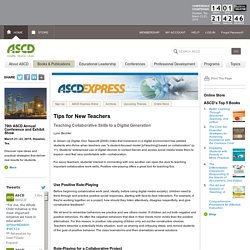
Students' widespread use of digital devices to contact friends and access social media leads them to expect—and feel very comfortable with—collaboration. For savvy teachers, students' interest in connecting with one another can open the door to teaching important collaborative work skills. Positive role-playing offers a great tool for teaching this. Use Positive Role-Playing Before beginning collaborative work (and, ideally, before using digital media socially), children need to think through and practice positive social responses, starting with face-to-face interaction. We all tend to remember behaviors we practice and see others model. Collaboration. July 2012 • tony@learninginhand.com Collaboration is the act of working together for a common goal.
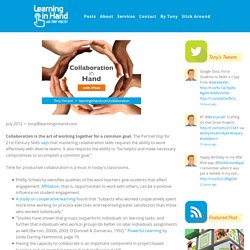
The Partnership for 21st Century Skills says that mastering collaboration skills requires the ability to work effectively with diverse teams. It also requires the ability to "be helpful and make necessary compromises to accomplish a common goal. " Easing the Pain of Student Collaboration. One of the most valued skills employers are looking for in an employee is the ability to collaborate.

This doesn’t just mean being “nice,” it means being able to be part of a productive and efficient team that gets the job done. And while a significant amount of adult time is devoted to teaching very young kids the basics of playing well with others, as students enter into middle and high school, little attention is given to developing a student’s ability to collaborate. At the same time, every teacher has experienced the pain that comes with student collaboration.
Get started with these sample contracts from New Tech Network, and watch the video below to learn more about team contracts. Grades 9-12 / All Subjects / Pbl. Www.cte.hawaii.edu/publications/Collab_web.pdf. Marana Unified School District - Productive Group Work. During Productive Group Work, students collaborate about content in order to clarify their understanding, defend their reasoning, and practice new skills.
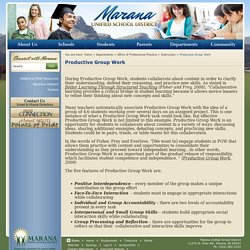
As stated in Better Learning Through Structured Teaching (Fisher and Frey, 2008), “Collaborative learning provides a critical bridge in student learning because it allows novice leaners to refine their thinking about new concepts and skills.” Many teachers automatically associate Productive Group Work with the idea of a group of 4-6 students working over several days on an assigned project. This is one instance of what a Productive Group Work task could look like, but effective Productive Group Work is not limited to this example. Productive Group Work is an opportunity for students to collaborate about content in a variety of ways: discussing ideas, sharing additional examples, debating concepts, and practicing new skills. Students could be in pairs, triads, or table teams for this collaboration.
Productive Group Work! We know that group work can be instructionally effective, but only if it is productive.
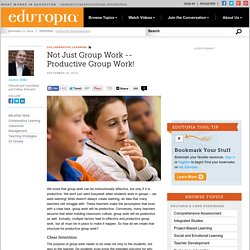
We don't just want busywork when students work in groups -- we want learning! Work doesn't always create learning, an idea that many teachers still struggle with. These teachers make the assumption that even with a clear task, group work will be productive. Conversely, many teachers assume that when building classroom culture, group work will be productive as well.